The Word Snoop (18 page)
Authors: Ursula Dubosarsky

Later, a kind of special joke developed out of this tendency of Tom’s, called a
Tom Swifty.
It’s a kind of pun, which is when you use a word that has two meanings at once to make people laugh. In a Tom Swifty, when Tom Swift says something, the writer uses a word that relates to what he is talking about to make a joke.
Tom Swifty.
It’s a kind of pun, which is when you use a word that has two meanings at once to make people laugh. In a Tom Swifty, when Tom Swift says something, the writer uses a word that relates to what he is talking about to make a joke.
Like this:
“I just love cats,” Tom Swift purred.
(Cats purr, get it?)
(Cats purr, get it?)
“I checked, and there really are 432,911
lollipops in the jar,” Tom Swift recounted.
(Tom counted the lollpops again, and then
he told you about it!)
lollipops in the jar,” Tom Swift recounted.
(Tom counted the lollpops again, and then
he told you about it!)
Then there’s another type of Tom Swifty where it’s the adverb (which is the word that tells you
how
he says something) that makes the joke. Take a look at the ones on the following page.
how
he says something) that makes the joke. Take a look at the ones on the following page.
“Who turned out the lights?” Tom Swift
said darkly.
said darkly.
“Can you lend me your pencil sharpener?”
asked Tom Swift bluntly.
asked Tom Swift bluntly.
“Would you like to pet my cocker spaniel?”
Tom Swift suggested doggedly.
Tom Swift suggested doggedly.
“I’m no good at darts,” Tom Swift
said aimlessly.
said aimlessly.
Try to make some up yourself. Once you start, it can be hard to stop (said the Word Snoop
open-endedly
. . .).
open-endedly
. . .).
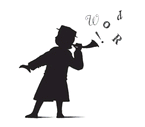
“My favorite dessert is chocolate mouse
with decimated coconut.”
with decimated coconut.”
Now, there’s something not quite right here. The person speaking has got some words and expressions a bit mixed up. This is called a malapropism. A malapropism is when you confuse words that may seem or sound similar, but have different meanings. So here the person probably meant that chocolate
mousse
was their favorite dessert, and they liked to eat it with
desiccated
coconut.
mousse
was their favorite dessert, and they liked to eat it with
desiccated
coconut.
Like
spoonerism
and
Tom Swifty,
the word
malapropism
is an eponym named after a person, in this case Mrs. Malaprop. She wasn’t a real person, but a character in a play called
The Rivals
, written by Irish playwright Richard Sheridan in 1775. He gave her the name Mrs. Malaprop from a French phrase
mal à propos,
which means “not quite right.” If you ever get to see
The Rivals,
you will find yourself laughing and laughing. (The Word Snoop had to leave the theater and get herself a large glass of water, she was laughing so much.) It’s not because of anything Mrs. Malaprop does, but the things she says. For example, she compares someone to an
allegory
on the Nile instead of an
alligator,
and even describes someone as “the very
pineapple
of politeness.” (Um, I think that should be
pinnacle,
Mrs. M!)
spoonerism
and
Tom Swifty,
the word
malapropism
is an eponym named after a person, in this case Mrs. Malaprop. She wasn’t a real person, but a character in a play called
The Rivals
, written by Irish playwright Richard Sheridan in 1775. He gave her the name Mrs. Malaprop from a French phrase
mal à propos,
which means “not quite right.” If you ever get to see
The Rivals,
you will find yourself laughing and laughing. (The Word Snoop had to leave the theater and get herself a large glass of water, she was laughing so much.) It’s not because of anything Mrs. Malaprop does, but the things she says. For example, she compares someone to an
allegory
on the Nile instead of an
alligator,
and even describes someone as “the very
pineapple
of politeness.” (Um, I think that should be
pinnacle,
Mrs. M!)
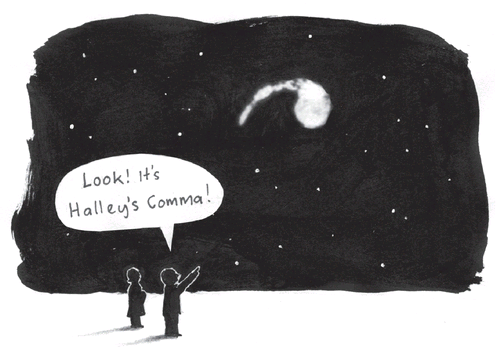
Of course, malapropisms existed long before Mrs. Malaprop appeared. Sometimes they are called
Dogberryisms
after a sort of policeman character called Dogberry who made the same sorts of mistakes as Mrs. Malaprop—and Dogberry appeared in a play by William Shakespeare that was written almost 200 years before
The Rivals.
Dogberryisms
after a sort of policeman character called Dogberry who made the same sorts of mistakes as Mrs. Malaprop—and Dogberry appeared in a play by William Shakespeare that was written almost 200 years before
The Rivals.
Malapropisms have been around as long as people have been speaking and writing and making mistakes (as we all do from time to time). They’re often found in the conversations of small children, who hear lots of new words each day. Sally Brown from Charles Schulz’s cartoon strip
Peanuts
talks about some cavemen who are “suddenly attacked by a huge
thesaurus”;
and the babies in the television cartoon
Rugrats
say things like: “Somebody got up on the wrong side of the
bread ”
and “For
feet’s
sake!”
Peanuts
talks about some cavemen who are “suddenly attacked by a huge
thesaurus”;
and the babies in the television cartoon
Rugrats
say things like: “Somebody got up on the wrong side of the
bread ”
and “For
feet’s
sake!”
But Mrs. Malaprop’s spirit lives on in grown-ups, too. Dorrie Evans, a favorite character in the long-running 1970s Australian soap opera
Number 96,
was a kind of modern-day Mrs. Malaprop, with remarks like: “Pardon me for
protruding
” (intruding) and “Life is not a bowl of
cherubs
” (cherries). And in the TV comedy
Kath and Kim,
both mother and daughter are constantly coming out with things like: “I don’t want to be rich. I want to be
effluent
” (affluent), or “The ozone diet? What does that
pacifically
(specifically) entail?” In fact, they are so well-known for this you will now sometimes find malapropisms called
Kath and Kimisms.
Number 96,
was a kind of modern-day Mrs. Malaprop, with remarks like: “Pardon me for
protruding
” (intruding) and “Life is not a bowl of
cherubs
” (cherries). And in the TV comedy
Kath and Kim,
both mother and daughter are constantly coming out with things like: “I don’t want to be rich. I want to be
effluent
” (affluent), or “The ozone diet? What does that
pacifically
(specifically) entail?” In fact, they are so well-known for this you will now sometimes find malapropisms called
Kath and Kimisms.
What makes malapropisms so funny? Well, the Austrian psychoanalyst Dr. Sigmund Freud believed that the mistakes we make in speech (sometimes known as “Freudian slips”) tell us a lot of truth about ourselves—more, in fact, than when we say everything correctly. So perhaps we laugh because we are shocked by the sudden truths a malapropism reveals . . .
Hmm. Next time you write a story or a play, why not try livening it up with a few malapropisms? In the meantime, see if you can work out what’s not quite right about the sentences on the following page.
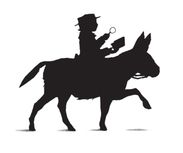
Malapropisms
1.
An amphibious person can write with both hands.
An amphibious person can write with both hands.
2.
Stop being such an idiom!
Stop being such an idiom!
3.
She was rushed to the hospital with a bad case of ammonia.
She was rushed to the hospital with a bad case of ammonia.
4.
The old man with gray hair looked very extinguished.
The old man with gray hair looked very extinguished.
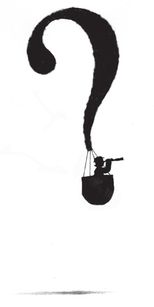
Have you ever read a book by Theodor Geisel? No? I bet you have. I’ll give you a hint, there’s this story about a cat with a hat . . .
Aha! Of course—Dr. Seuss. But
Dr. Seuss
wasn’t the name he was born with. It was his pen name, a name a person uses when he publishes a book. This is also known as a
pseudonym,
Greek for “false name,” or a
nom de plume,
which is French for “name of pen.” In Theodor Geisel’s case, Seuss was his middle name. He began using it when he was a young man, drawing and writing for a university magazine. Later, he added the “Dr.” for fun, in honor of the doctoral degree he never managed to get at the university.
Dr. Seuss
wasn’t the name he was born with. It was his pen name, a name a person uses when he publishes a book. This is also known as a
pseudonym,
Greek for “false name,” or a
nom de plume,
which is French for “name of pen.” In Theodor Geisel’s case, Seuss was his middle name. He began using it when he was a young man, drawing and writing for a university magazine. Later, he added the “Dr.” for fun, in honor of the doctoral degree he never managed to get at the university.
So why didn’t he just use his own name in the first place? Well, sometimes writers want to use a different name for different kinds of writing. The mathematics professor Charles Lutwidge Dodgson used the pen name Lewis Carroll when he wrote
Alice’s Adventures in Wonderland,
because he wanted to keep his real name for his books about mathematics and philosophy. It was the same for Daniel Handler, a writer for adults, when he decided to use a pen name for his series of unfortunately eventful children’s books. You know who I mean . . .
Lemony Snicket.
Alice’s Adventures in Wonderland,
because he wanted to keep his real name for his books about mathematics and philosophy. It was the same for Daniel Handler, a writer for adults, when he decided to use a pen name for his series of unfortunately eventful children’s books. You know who I mean . . .
Lemony Snicket.
There can be all sorts of other reasons for using a pen name. The French novelist Albert Camus, who won the Nobel Prize for literature, wrote under the pen name Bauchard during World War II to trick his enemies. The Irish writer Oscar Wilde used the name Sebastian Melmoth after he came out of prison, because he thought that people might be prejudiced against him. And the playwright Molière took on this one-word name so his family wouldn’t be embarrassed (in those days people didn’t think the theater was a respectable place to work). His real name was Jean-Baptiste Poquelin.
Some female writers have written under pen names too, either because they wanted to keep their privacy, or because they were afraid that people didn’t think women should write books. This happened a lot in the nineteenth century. Jane Austen, the author of
Pride and Prejudice,
wrote all her novels anonymously, without any name on them at all. (Now that’s shy!) And one of the greatest writers of the nineteenth century, George Eliot, was actually a woman named Mary Ann Evans. The wonderful Australian novelist Henry Handel Richardson was really named Ethel Richardson, just as fellow writer Miles Franklin’s real first name was Stella.
Pride and Prejudice,
wrote all her novels anonymously, without any name on them at all. (Now that’s shy!) And one of the greatest writers of the nineteenth century, George Eliot, was actually a woman named Mary Ann Evans. The wonderful Australian novelist Henry Handel Richardson was really named Ethel Richardson, just as fellow writer Miles Franklin’s real first name was Stella.
It can work the other way as well—a man might choose to write under a woman’s name. The author of
The Wizard of Oz,
L. Frank Baum, also used the names Laura Bandcroft and Edith Van Dyne. He must have wondered exactly who he was sometimes . . .
The Wizard of Oz,
L. Frank Baum, also used the names Laura Bandcroft and Edith Van Dyne. He must have wondered exactly who he was sometimes . . .
It’s not surprising, when you think about it, that authors like to use pen names. After all, it comes naturally to a writer to make up characters. It’s fun and exciting to become another person for a while—like being an undercover agent! The Danish philosopher Søren Kierkegaard sometimes signed his books
John of Silence
. Hmm, that gets me thinking. How about
Elspeth of Imagination
or
Ali the Ambidextrous
or . . .
John of Silence
. Hmm, that gets me thinking. How about
Elspeth of Imagination
or
Ali the Ambidextrous
or . . .
What pen name would you use, snoops? You could try using an anagram of your own name. That’s what the inventor of the telephone, Alexander Graham Bell, did—he wrote articles under the name H. A. Largelamb, a pen name he made up for himself as a child. Or you could just let your imagination go wild! Here are a few nutty pen names of some very respectable authors, just to give you some ideas.
Michael Angelo Titmarsh
C. J. Yellowplush, Esq.
Miss Tickletoby
(Real name: William Makepeace Thackeray,
author of
Vanity Fair
)
C. J. Yellowplush, Esq.
Miss Tickletoby
(Real name: William Makepeace Thackeray,
author of
Vanity Fair
)
Malachi Malagrowther
Captain Clutterbuck
Crystal Croftangry
(Real name: Sir Walter Scott, author of
Ivanhoe
)
Captain Clutterbuck
Crystal Croftangry
(Real name: Sir Walter Scott, author of
Ivanhoe
)
Isaac Bickerstaff
A. Dissenter
M. B. Drapier
(Real name: Jonathan Swift,
author of
Gulliver’s Travels
)
A. Dissenter
M. B. Drapier
(Real name: Jonathan Swift,
author of
Gulliver’s Travels
)
Hmm,
the Word Snoop
. Do you think that could possibly be a pen name . . . ?
the Word Snoop
. Do you think that could possibly be a pen name . . . ?
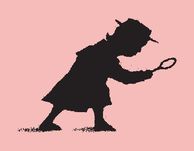
Uh-oh, Word Snoops, we’re up to the second to the last code! (Will you miss them when they’re gone?) See how quickly you can figure this one out. (Hint: How well can you count?)
WHO AM I?
MY FIRST IS IN WALRUS
MY SECOND IS IN DOLPHIN
MY THIRD IS IN PORCUPINE
MY FOURTH IS IN GANDER
MY FIFTH IS IN GOATS
MY SIXTH IS IN PIT-PONY
MY SEVENTH AND EIGHTH ARE IN COCKATOO
MY NINTH IS IN RED SHRIMP
MY FIRST IS IN WALRUS
MY SECOND IS IN DOLPHIN
MY THIRD IS IN PORCUPINE
MY FOURTH IS IN GANDER
MY FIFTH IS IN GOATS
MY SIXTH IS IN PIT-PONY
MY SEVENTH AND EIGHTH ARE IN COCKATOO
MY NINTH IS IN RED SHRIMP
Other books
One Foot In The Gravy by Rosen, Delia
Over. (This. Is. Not. Over. #2) by Dianne, Shannon
The Missing Italian Girl by Barbara Pope
Fierce Defender: Book 2, Hard to Handle trilogy by Kane, Janine
Sometimes a Great Notion by Ken Kesey
Martyr by Rory Clements
Hard Luck Money by J.A. Johnstone
A Sliver of Stardust by Marissa Burt
NovaForge by Toney, Scott
Sensitive by Sommer Marsden
